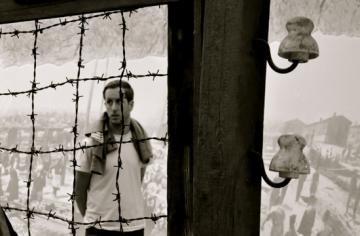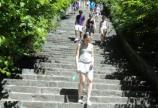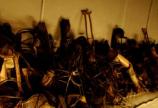The eye of history--Holocaust Field School
- Tara Sharpe

Mounds of leather trunks. Thousands of prosthetic limbs. Streets dotted with brass stones carved with names.
These are some of the images now part of the personal history of nearly two dozen University of Victoria students after a visit to Central Europe in May 2011. The I-witness Holocaust Field School, launched by the Department of Germanic and Slavic Studies as a three-unit course this year, was held in Germany, Poland and Austria.
The new field school explores how the sights, memories and history of the Holocaust (Shoah in Hebrew) have been preserved at historical sites, museums and monuments, and helps build an understanding of how the lessons of that time are relevant today. UVic is the only Canadian university offering a course of this kind for undergraduate students.
The intention of the program’s founders—UVic professor Dr. Helga Thorson and project director Michael Gans, a UVic graduate student—was to provide students with an opportunity to acquire a deeper understanding of antisemitism, religious intolerance, homophobia and stigmatization of mentally and physically challenged communities. It also probed how national narratives about the Holocaust differ among the three countries.
“The field school is the most rewarding project I’ve ever done—academically, socially, personally,” says Thorson. “It was really intense from the first minute to the last.”
The inaugural class was composed of 19 undergraduates and four graduate students from Germanic and Slavic studies, European studies, English, history, education, psychology and history in art. The first week took place at UVic including guest lectures and sessions with local Holocaust survivors, followed by 20 days in Europe. The group, including Thorson and Gans (both in the Department of Germanic and Slavic Studies), arrived on May 8 in Berlin.
The typical schedule included class sessions in the mornings and site excursions in the afternoon. The visits included the Memorial to the Murdered Jews of Europe, Jewish Museum, Roma-Sinti Holocaust Memorial, Gay Holocaust Memorial and Weißensee Cemetery in Berlin, Germany; the former Sachsenhausen and Ravensbrück Concentration Camps and other memorial sites in Germany; the Galicia Jewish Museum in Krakow, Poland; the Auschwitz-Birkenau Memorial and Museum in Poland; and the former Mauthausen Concentration Camp and the Schloß Hartheim castle in Austria.
At Auschwitz, hallways are lined with encased piles of belongings such as artificial limbs and suitcases. In Vienna, another reminder is underfoot. Initiated as a memorial project in the 1990s, thousands of small stumbling blocks (Stolpersteine) are now scattered amidst the cobbles and paving stones in streets across Germany, Austria, Czech Republic, Hungary, Italy and The Netherlands. The brass stones are stamped with the names, fate, and dates of birth, deportation and death of those who were deported or persecuted. They are placed in front of the last home of each person. On the day of a site visit in Berlin, Thorson found the Stolperstein bearing her own great-grandmother’s name.
A key theme of next year’s field school will be the expressions of the Shoah through art and visual depiction. “The cultural life of Jews before all this happened, and where they fit in, are very important aspects of this course,” says Gans. And 70 years later, “the Holocaust is the moral and ethical question of our time. It touches on every aspect of our lives.”
This was a crucial instructive element of the field school, and the lesson is much sharper than stubbing a toe on one of the stumbling stones. The I-witness group witnessed racism during their trip; for instance, a tour guide in Krakow made an antisemitic comment. In Germany, a recent report quoted in a TIME magazine blog indicates nearly 16,500 politically motivated criminal acts by right-wing extremists took place last year of which 11,384 involved displaying swastikas or giving the Nazi salute. And here in Canada, a report released on July 7 by a panel of Members of Parliament is urging the federal government to take action on the increase of antisemitic incidents in our country.
“We are now eyewitnesses,” says Thorson, hinting at the play on words of the field school’s name. Her tone is wholly serious: “When we asked the students how they felt after being there, they said they’d moved from being observers to being eyewitnesses of the memorialization process.”
This sentiment forges a grim link to another story. During the tour of Austria’s Hartheim castle, a site of the Nazi euthanasia program responsible for killing people with mental or physical disabilities, one student noticed a name on the lists of thousands and remembered seeing it earlier on the trip. She subsequently discovered that Lea Wieselberg, a mother of four relocated to the Jewish ghetto in Vienna, could not tolerate the pressure and threw a flowerpot out the window at Nazis marching below. Her family was able to convince them she had lost her mind and should not be sent to the camps. But instead she was sent to Hartheim castle.
One student recalls her experience in the Auschwitz-Birkenau museum: “It was poorly lit and chilly down in the cellar; being unable to leave caused a sense of powerlessness and slight panic. This feeling was incomparable to what actual prisoners felt during their time in Auschwitz and in this very jail. I was not forced to stand; I was not alone, or in complete darkness.”
In an eerie echo of entrapment, the group nearly missed their scheduled departure from Europe. Thousands of flights were cancelled at the end of May due to ash from Iceland’s Grimsvotn volcano. Gans acknowledges Colleen Jackson, manager of Travel Cuts at UVic, and her deft planning of alternate arrangements. Thankfully it all “literally blew over,” adds Thorson. The group flew home as planned on May 28 from Berlin.
Upon returning to Canada, the students will share their experiences through formal presentations and discussions. On Wed., July 20, the public is invited to a special exhibit by several of the I-witness students who will present their experiences and describe what the field school meant to them. The event will take place from 1:30 to 2:30 p.m. in the Michael Audain Gallery in UVic’s Visual Arts building.
Dr. James Anglin and UVic’s Office of International Affairs initially championed the I-witness course concept after it was developed by Thorson and Gans in Spring 2010, and the field school continues to garner support across campus and beyond.
Community gifts and personal donations have been received from generous private donors in Victoria and Vancouver as well as various organizations including the Lohn Foundation, the Pekarsky Foundation, the Zalkow Foundation, the Kolot Mayim Reform Temple in Victoria, Saanich Bikram Yoga, the Victoria Holocaust Remembrance and Education Society, the Jewish Federation of Victoria and Vancouver Island, and the UVic Holocaust Speaker Series.
Excerpts from the students’ blog during the trip. More photos from the trip. Upcoming info on the next field school.
It takes place May 2012. Application deadline Nov. 1.








